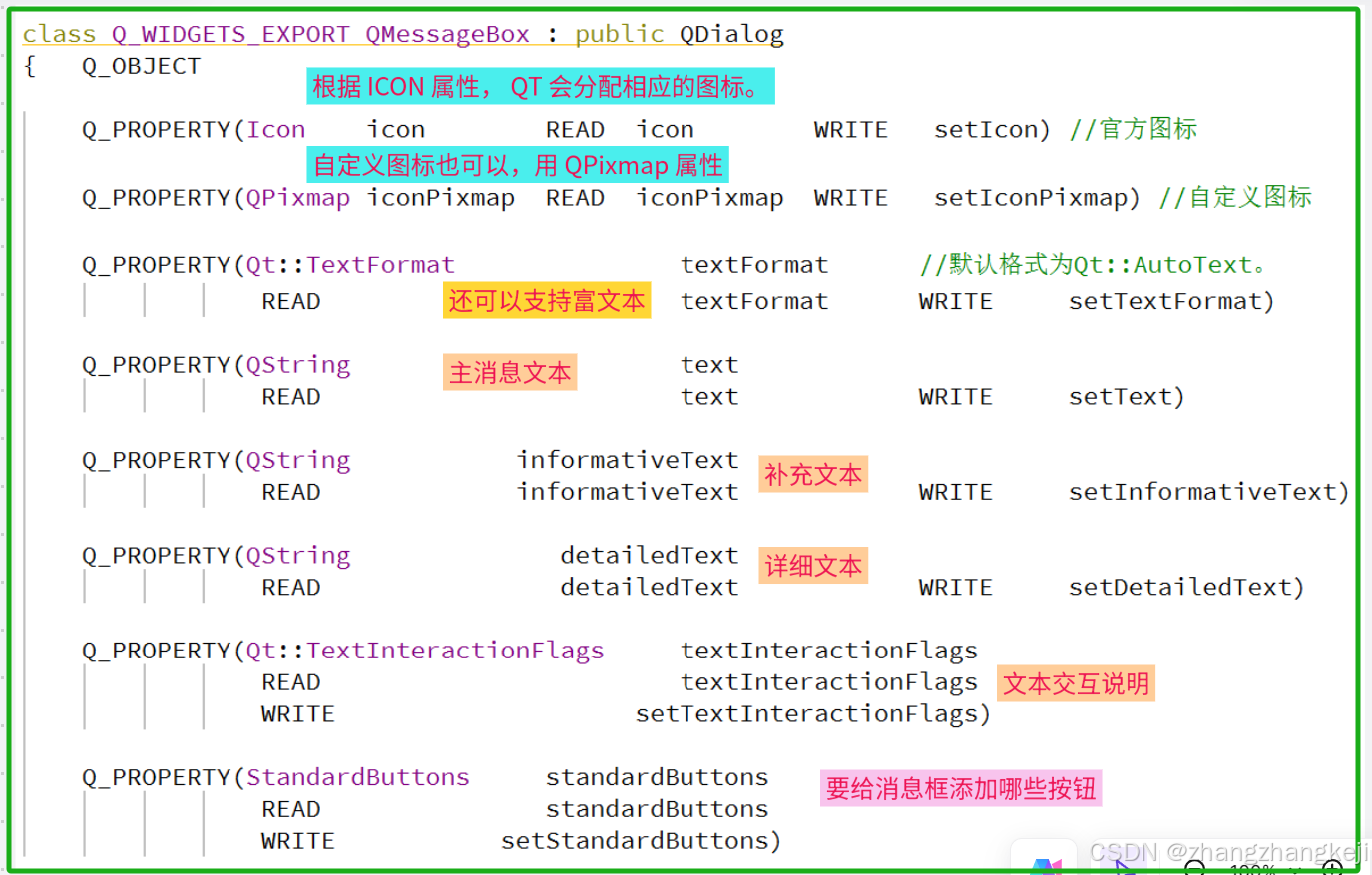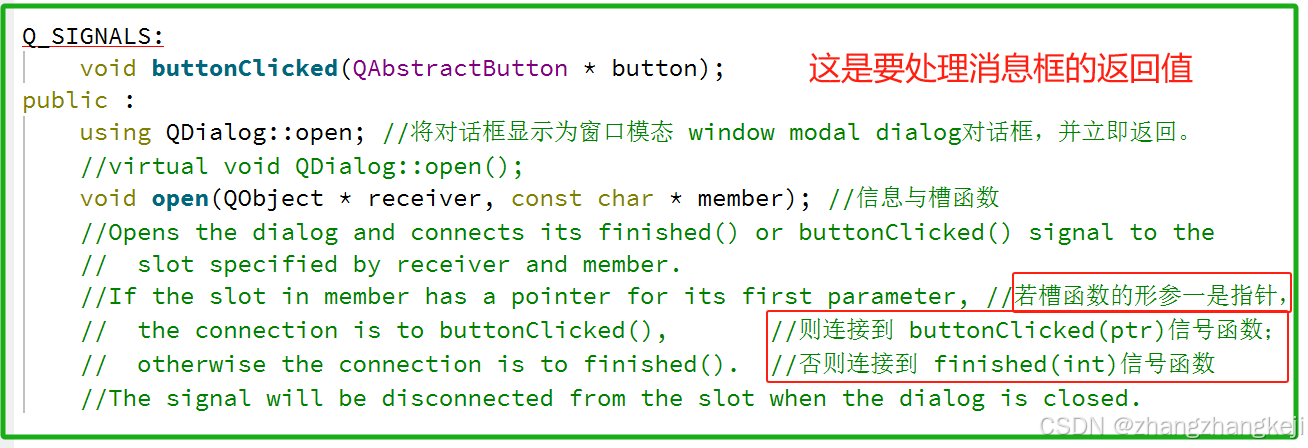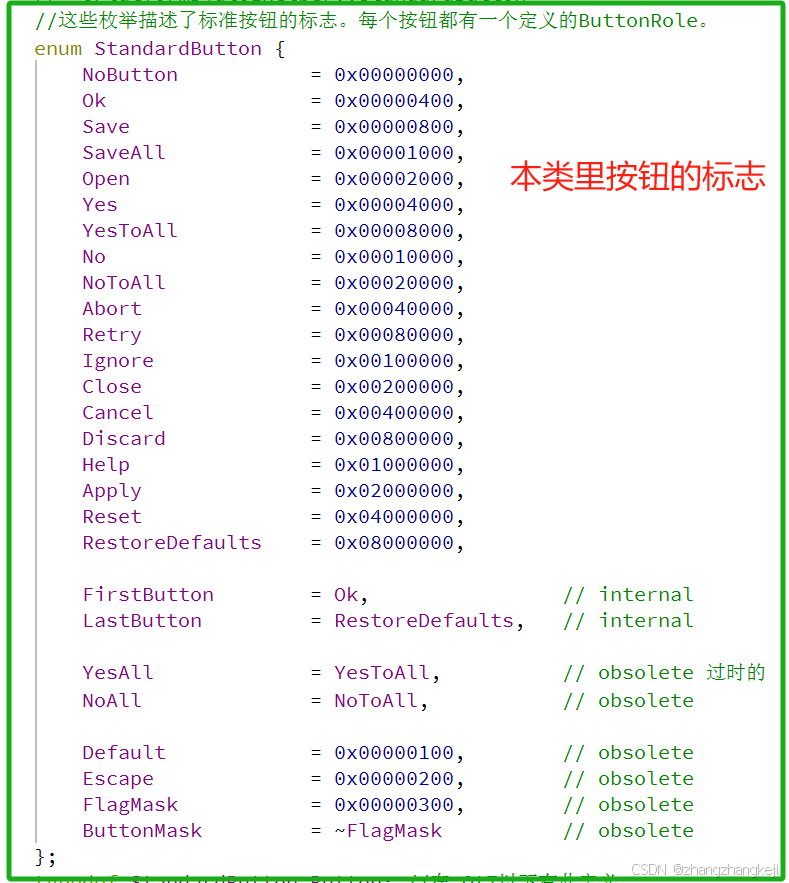(1)消息对话框里,分为通知消息,询问消息,提醒消息,错误消息。可以直接使用本类的静态函数,简单。但 QT 的官方说明里,建议使用动态成员函数组件的消息框,而非使用静态函数。理由是静态函数里无法携带更多的文本内容。但基于 QMessageBox 的功能来定制消息框,更难。

++

++

++

++还有很多的成员函数,来管理消息框里的按钮,涉及按钮的增删改查。就不一一列举了,感觉这不容易的知识。暂时不深学了。
(2)接着学习最后的静态成员函数 :

++测试一下 :

(3)本源代码定义于头文件 qmessagebox . h :
cpp
#ifndef QMESSAGEBOX_H
#define QMESSAGEBOX_H
#include <QtWidgets/qtwidgetsglobal.h>
#include <QtWidgets/qdialog.h>
QT_REQUIRE_CONFIG(messagebox);
QT_BEGIN_NAMESPACE
class QLabel;
class QMessageBoxPrivate;
class QAbstractButton;
class QCheckBox;
/*
The QMessageBox class provides a modal dialog for informing the user or
for asking the user a question and receiving an answer.
Detailed Description :
-个消息框会显示主要文本以提醒用户某种情况,
进一步的说明性文本以进一步解释提醒内容或询问用户问题,
以及可选的详细文本以在用户请求时提供更多的数据。
消息框还可以显示图标和用于接受用户响应的标准按钮。
提供了两种使用QMessageBox的API,即基于属性的API和静态函数。
调用静态函数是更简单的方法,但其灵活性不如使用基于属性的API,且显示结果的信息量也较小。
建议使用基于属性的API。
The Property-based API :
要使用基于属性的API,首先需要构造一个QMessageBox的实例,然后设置所需的属性,
最后调用exec()来显示消息。最简单的配置方式仅设置消息文本属性。
QMessageBox msgBox;
msgBox.setText("The document has been modified.");
msgBox.exec();
用户必须点击OK按钮才能关闭消息框。在消息框被关闭之前,其余的GUI将保持锁定状态。dismiss解散。
-个更好的方法不仅在于提醒用户注意某个事件,还在于询问用户对此应采取何种行动。
将这个问题存储在"信息文本属性"中,并将"标准按钮属性"设置为您想要的按钮集合,作为用户可能的响应选项。
这些按钮是通过使用按位或运算符结合来自"标准按钮"的值来指定的。
按钮的显示顺序取决于平台。例如,在Windows上,"保存"按钮会显示在"取消"按钮的左侧,
而在MacOS上,顺序则相反。
标记其中一个标准按钮为默认按钮。
QMessageBox msgBox;
msgBox.setText("The document has been modified.");
msgBox.setInformativeText("Do you want to save your changes?");
msgBox.setStandardButtons(QMessageBox::Save | QMessageBox::Discard
| QMessageBox::Cancel );
msgBox.setDefaultButton(QMessageBox::Save);
int ret = msgBox.exec();
这是《macOS指南》中推荐的做法。类似的指南也适用于其他平台,
但请注意不同平台在处理信息文本时的不同方式。
exec()插槽返回被点击按钮的标准按钮 StandardButtons 值。
switch (ret) {
case QMessageBox::Save: // Save was clicked
break;
case QMessageBox::Discard: // Don't Save was clicked
break;
case QMessageBox::Cancel: // Cancel was clicked
break;
default: // should never be reached 这一条不应被达到
break;
}
为了向用户提供更多信息,以便他回答问题,应设置详细的 detailed text 文本属性。
如果设置了详细的 detailed text 文本属性, Show Details... 按钮将会显示。
Clicking the Show Details... button displays the detailed text.
Rich Text and the Text Format Property :
详细文本 detailed text 属性总是被解释为纯文本。
主文本 main text 和信息文本 informative text 属性可以是纯文本或富文本。
这些字符串将根据文本格式 text format 属性的设置来解释。默认设置为自动文本 auto-text。
请注意,对于某些包含XML元字符的纯文本字符串,
自动文本 auto-text,富文本检测测试 rich text detection test 可能会失败,
导致纯文本字符串被错误地解释为富文本。
在这些罕见的情况下,使用Qt::convertFromPlainText()将纯文本字符串转换为视觉上等效的富文本字符串,
或者使用setTextFormat()显式地设置文本格式 text format 属性。
Severity Levels and the Icon and Pixmap Properties :
QMessageBox支持四种预定义的讯息严重程度级别或讯息类型,
实际上它们之间的区别仅在于各自显示的预定义图标.
通过将图标 icon属性设置为预定义的图标之一,可以指定这四种预定义讯息 predefined icons类型之一。
以下规则仅供参考:
i Information For reporting information about normal operations.
问号? Question For asking a question during normal operations.
叹号! Warning For reporting non-critical errors.
叉 X Critical For reporting critical errors.
预定义的图标并非由 QMessageBox定义,而是由样式提供。默认值为 NoIcon。
在所有情况下,消息框在其他方面是相同的。
在使用标准图标时,应采用表格中推荐的那个,或者采用适用于您平台的相关样式指南所推荐的那个。
如果没有任何标准图标适合您的消息框,您可以通过设置 icon pixmap属性(而非图标icon属性)来使用自定义图标。
总之,要设置图标,请使用setIcon()为标准图标之一设置图标,或者使用setIconPixmap()为自定义图标设置图标。
The Static Functions API :
使用静态函数API构建消息框虽然方便,但其灵活性却不如使用基于属性的API,
因为静态函数签名中缺少用于设置信息性文本 informative text 和详细文本 detailed text 属性的参数。
一个变通方法是使用"标题title"参数作为消息框的主文本,而使用"文本text"参数作为消息框的信息性文本。
由于这种做法有明显的缺点,导致消息框的可读性降低,因此平台指南并不推荐使用。
微软Windows用户界面指南建议使用应用程序名称 application name 作为窗口的标题 window's title,
这意味着如果您除了主文本外还有一个信息性文本,您必须将其连接到text参数。
请注意,静态函数签名相对于其按钮参数已有所更改,
这些参数现在用于设置标准按钮 standard buttons 和默认按钮 default button。
静态函数可用于创建信息框information()、问题框question()、警告框warning()和关键消息框critical()。
int ret = QMessageBox::warning(this, tr("My Application"),
tr("The document has been modified.\n Do you want to save your changes?"),
QMessageBox::Save | QMessageBox::Discard | QMessageBox::Cancel,
QMessageBox::Save);
标准对话框示例展示了如何使用QMessageBox和其他内置的Qt对话框。
Advanced Usage :
如果标准按钮 standard buttons不足以满足您的消息框需求,
您可以使用带文本和按钮角色 buttonRole 的`addButton()、重载函函数来添加自定义按钮。
`ButtonRole`由`QMessageBox`用于确定屏幕上按钮的排列顺序(各平台有所不同)。
在调用`exec()、后,您可以测试`clickedButton()、的值。例如:
QMessageBox msgBox;
QPushButton * connectButton = msgBox.addButton(tr("Connect"), QMessageBox::ActionRole);
QPushButton * abortButton = msgBox.addButton(QMessageBox::Abort);
msgBox.exec();
if (msgBox.clickedButton() == connectButton) { // connect
} else if (msgBox.clickedButton() == abortButton) { // abort
}
Default and Escape Keys :
使用`setDefaultButton()、可以指定默认按钮(即按下Enter键时激活的按钮)。
如果没有指定默认按钮,`QMessageBox`会根据对话框中使用的按钮的按钮角色button roles尝试找到相应的默认按钮。
逃逸 escape 按钮(即按下 Esc 键时激活的按钮)可以使用 setEscapeButton()方法来指定。
如果没有指定逃逸按钮QMessageBox会尝试根据以下规则找到合适的按钮:
1.如果只有一个按钮,则该按钮在按下ESc时被激活。
2.如果有一个取消 Cancel按钮,它就是按下ESc时激活的按钮。
3.如果恰好有一个按钮具有拒绝角色 the Reject role或否定角色the the No role,则该按钮在按下ESc时被激活。
当无法通过这些规则确定退出按钮时,按下ESc没有效果。
*/
class Q_WIDGETS_EXPORT QMessageBox : public QDialog
{
Q_OBJECT
/*
此属性持有消息框的图标
消息框的图标可以通过以下值之一指定:
QMessageBox::NoIcon
QMessageBox::问题
QMessageBox::信息
QMessageBox::警告 warning
QMessageBox::Critical
默认值是QMessageBox::NoIcon。
用于显示实际图标的像素图取决于当前的GUI样式。
您还可以通过设置 iconPixmap属性来为图标设置自定义像素图。
*/
Q_PROPERTY(Icon icon READ icon WRITE setIcon) //官方图标
Q_PROPERTY(QPixmap iconPixmap READ iconPixmap WRITE setIconPixmap) //自定义图标
/*
此属性持有当前图标。消息框当前使用的图标。
请注意,通常很难绘制一个在所有GUI风格中都显得合适的像素图。
您可能需要在每个平台上提供不同的像素图。
默认情况下,此属性未定义。
*/
//class QLabel::Q_PROPERTY(Qt::TextFormat textFormat ...)
//这个枚举用于可以同时显示纯文本和富文本的小部件中,例如QLabel。
//它用于决定是否将文本字符串解释为其中之一或另一种。
//这通常是通过将一个eum值传递给 QTextEdit::setTextFormat ()函数来完成的。
// enum Qt::TextFormat { //这是 label 上文本的格式
// PlainText, //文本字符串被解释为一个普通文本字符串。
// RichText, //文本字符串被解释为富文本字符串。请参阅支持的HTML子集以获取富文本的定义。
// AutoText, //如果Qt::mayBeRichText()返回true,
// //则将文本字符串解释为Qt::RichText;否则,将其解释为Qt::PlainText.
// MarkdownText //文本字符串被解释为Markdown格式化的文本。此枚举值在Qt5.14中添加。
//};
Q_PROPERTY(Qt::TextFormat textFormat //默认格式为Qt::AutoText。
READ textFormat WRITE setTextFormat)
//此属性保存消息框显示文本的格式。消息框当前使用的文本格式。
/*
此属性持有要显示的消息框文本。
文本将被解释为纯文本或富文本,具体取决于文本格式设置(QMessageBox::textFormat).
默认设置为 Qt::AutoText,即消息框将尝试自动检测文本的格式。
此属性的默认值为空字符串。
*/
Q_PROPERTY(QString text
READ text WRITE setText)
/*
此属性包含提供消息更详细描述的信息文本。
说明性文本可以用来扩展`text()',以向用户提供更多信息。
在Mac上,该文本会显示在`text()、下方,采用小型系统字体。
在其他平台上,它只是被附加到已有的文本上。
默认情况下,此属性包含一个空字符串。
*/
Q_PROPERTY(QString informativeText
READ informativeText WRITE setInformativeText)
Q_PROPERTY(QString detailedText
READ detailedText WRITE setDetailedText)
/*
此属性包含在详细信息区域中要显示的文本。文本将被解释为纯文本。默认情况下,此属性包含一个空字符串。
*/
//指定消息框标签应如何与用户输入交互。默认值取决于样式。
Q_PROPERTY(Qt::TextInteractionFlags textInteractionFlags
READ textInteractionFlags
WRITE setTextInteractionFlags)
/*
//QLabel :: Q_PROPERTY(Qt::TextInteractionFlags textInteractionFlags
// READ textInteractionFlags WRITE setTextInteractionFlags)
//本枚举类应用于标签的 属性 textInteractionFlags.本属性也用于文本框.
//这个枚举定义了文本显示控件如何对用户输入做出反应。
enum Qt::TextInteractionFlag {
NoTextInteraction = 0, //无法与文本进行交互。
TextSelectableByMouse = 1, //文本可以通过鼠标选择,
//并使用上下文菜单或标准键盘快捷键复制到剪贴板。
TextSelectableByKeyboard = 2, //可以通过键盘上的光标键选择文本。显示一个文本光标。
LinksAccessibleByMouse = 4, //链接可以通过鼠标进行高亮和激活。
LinksAccessibleByKeyboard = 8, //链接可以通过按Tab键进行聚焦,并通过按Enter键激活。
TextEditable = 16,//文本可以完全编辑。
TextEditorInteraction = TextSelectableByMouse
| TextSelectableByKeyboard
| TextEditable, //default for a text editor.
TextBrowserInteraction = TextSelectableByMouse //default for QTextBrowser.
| LinksAccessibleByMouse
| LinksAccessibleByKeyboard
};
Q_DECLARE_FLAGS(TextInteractionFlags, TextInteractionFlag)
Q_DECLARE_OPERATORS_FOR_FLAGS(TextInteractionFlags)
*/
//消息框中标准按钮的集合.此属性控制消息框使用的标准按钮。默认情况下,此属性不包含任何标准按钮。
Q_PROPERTY(StandardButtons standardButtons
READ standardButtons
WRITE setStandardButtons)
protected:
bool event(QEvent * e ) override;
void resizeEvent(QResizeEvent * event) override;
void showEvent(QShowEvent * event) override;
void closeEvent(QCloseEvent * event) override;
void keyPressEvent(QKeyEvent * event) override;
void changeEvent(QEvent * event) override;
private:
Q_PRIVATE_SLOT(d_func(), void _q_buttonClicked(QAbstractButton *))
Q_PRIVATE_SLOT(d_func(), void _q_clicked(QPlatformDialogHelper::StandardButton,
QPlatformDialogHelper::ButtonRole))
Q_DISABLE_COPY(QMessageBox)
Q_DECLARE_PRIVATE(QMessageBox)
Q_SIGNALS:
void buttonClicked(QAbstractButton * button);
public :
using QDialog::open; //将对话框显示为窗口模态 window modal dialog对话框,并立即返回。
//virtual void QDialog::open();
void open(QObject * receiver, const char * member); //信息与槽函数
//Opens the dialog and connects its finished() or buttonClicked() signal to the
// slot specified by receiver and member.
//If the slot in member has a pointer for its first parameter, //若槽函数的形参一是指针,
// the connection is to buttonClicked(), //则连接到 buttonClicked(ptr)信号函数;
// otherwise the connection is to finished(). //否则连接到 finished(int)信号函数
//The signal will be disconnected from the slot when the dialog is closed.
public:
explicit QMessageBox(QWidget * parent = nullptr);
QMessageBox(Icon icon, const QString & title, const QString & text,
StandardButtons buttons = NoButton, QWidget * parent = nullptr,
Qt::WindowFlags flags = Qt::Dialog | Qt::MSWindowsFixedSizeDialogHint);
~QMessageBox();
enum Icon { // keep this in sync with QMessageDialogOptions::Icon
NoIcon = 0,
Information = 1, //表明这条消息没有什么特别之处。
Warning = 2, //表示该消息是警告,但可以处理。
Critical = 3, //表明该消息代表了一个关键问题。
Question = 4 //表明该消息正在提出一个问题。
};
Q_ENUM(Icon)
// Q_PROPERTY(Icon icon
// READ icon WRITE setIcon) //官方图标
Icon icon() const;
void setIcon(Icon);
// Q_PROPERTY(QPixmap iconPixmap
// READ iconPixmap WRITE setIconPixmap) //自定义图标
QPixmap iconPixmap() const;
void setIconPixmap(const QPixmap &pixmap);
// // enum Qt::TextFormat { PlainText, RichText, AutoText, MarkdownText };
// Q_PROPERTY(Qt::TextFormat textFormat //默认格式为Qt::AutoText。
// READ textFormat WRITE setTextFormat)
Qt::TextFormat textFormat() const;
void setTextFormat(Qt::TextFormat format);
// Q_PROPERTY(QString text // 最基础的消息文本
// READ text WRITE setText)
QString text() const;
void setText(const QString & text);
// Q_PROPERTY(QString informativeText //更详细描述的信息文本
// READ informativeText WRITE setInformativeText)
QString informativeText() const;
void setInformativeText(const QString & text);
// Q_PROPERTY(QString detailedText //detailed 中的文本
// READ detailedText WRITE setDetailedText)
QString detailedText() const;
void setDetailedText(const QString & text);
// //指定消息框标签应如何与用户输入交互,如何选中,如何编辑,是否打开超链接等等。默认值取决于样式。
// Q_PROPERTY(Qt::TextInteractionFlags textInteractionFlags
// READ textInteractionFlags
// WRITE setTextInteractionFlags)
Qt::TextInteractionFlags textInteractionFlags() const;
void setTextInteractionFlags(Qt::TextInteractionFlags flags);
//keep this in sync with QDialogButtonBox::StandardButton and
// QPlatformDialogHelper::StandardButton
//这些枚举描述了标准按钮的标志。每个按钮都有一个定义的ButtonRole。
enum StandardButton {
NoButton = 0x00000000,
Ok = 0x00000400,
Save = 0x00000800,
SaveAll = 0x00001000,
Open = 0x00002000,
Yes = 0x00004000,
YesToAll = 0x00008000,
No = 0x00010000,
NoToAll = 0x00020000,
Abort = 0x00040000,
Retry = 0x00080000,
Ignore = 0x00100000,
Close = 0x00200000,
Cancel = 0x00400000,
Discard = 0x00800000,
Help = 0x01000000,
Apply = 0x02000000,
Reset = 0x04000000,
RestoreDefaults = 0x08000000,
FirstButton = Ok, // internal
LastButton = RestoreDefaults, // internal
YesAll = YesToAll, // obsolete 过时的
NoAll = NoToAll, // obsolete
Default = 0x00000100, // obsolete
Escape = 0x00000200, // obsolete
FlagMask = 0x00000300, // obsolete
ButtonMask = ~FlagMask // obsolete
};
typedef StandardButton Button; //在 Qt7以下有此定义
Q_DECLARE_FLAGS(StandardButtons, StandardButton)
Q_FLAG(StandardButtons)
// Q_PROPERTY(StandardButtons standardButtons //消息框中标准按钮的集合.
// READ standardButtons
// WRITE setStandardButtons)
StandardButtons standardButtons() const;
StandardButton standardButton(QAbstractButton * button ) const;
void setStandardButtons(StandardButtons buttons);
void setWindowTitle (const QString & title);
void setWindowModality(Qt::WindowModality windowModality);
//enum Qt::WindowModality { NonModal, WindowModal, ApplicationModal };
//返回对话框中显示的复选框。如果没有设置复选框,则为nullptr。
QCheckBox * checkBox() const;
void setCheckBox(QCheckBox * cb);
//在消息对话框上设置复选框 cb。该消息框将拥有复选框的权限take ownership。
//参数cb可以设为 nullptr,以从消息框中移除现有的复选框。
//这个枚举描述了可用于描述按钮盒中按钮的角色。这些角色的组合用作标志,以描述其行为的不同方面。
// keep this in sync with QDialogButtonBox::ButtonRole and
// QPlatformDialogHelper::ButtonRole
enum ButtonRole {
InvalidRole = -1, //The button is invalid.
//Clicking the button causes the dialog to be accepted (e.g. OK).
AcceptRole, //点击按钮会接受对话框(例如:确定)
//Clicking the button causes the dialog to be rejected (e.g. Cancel).
RejectRole,
DestructiveRole, //点击按钮会导致破坏性更改(例如,放弃更改)并关闭对话框。
ActionRole, //点击按钮会改变对话框中的元素。
HelpRole, //可以点击按钮请求帮助。
YesRole, //The button is a "Yes"-like button.
NoRole, //The button is a "No"-like button.
ResetRole, //该按钮将对话框的字段重置为默认值。
ApplyRole, //The button applies current changes.
NRoles
};
//返回一个指向标准按钮 which的指针,如果此消息框中不存在标准按钮,则返回nullptr。
QAbstractButton * button (StandardButton which ) const;
QAbstractButton * clickedButton () const; //返回用户点击的按钮,
//如果用户按下了 ESc键且未设置 escape button按钮,则返回nullptr。
//如果exec()尚未被调用,返回nullptr。
QList<QAbstractButton *> buttons() const; //返回已添加到消息框的所有按钮的列表。
ButtonRole buttonRole(QAbstractButton * button) const;
//返回指定按钮的按钮角色。如果按钮为空指针或尚未添加到消息框中,此函数将返回InvalidRole。
//Adds a standard button to the message box if it is valid to do so,
// and returns the push button.
QPushButton * addButton(StandardButton button);
//Adds the given button to the message box with the specified role.
void addButton(QAbstractButton * button, ButtonRole role);
QPushButton * addButton(const QString & text , ButtonRole role);
//Creates a button with the given text,
// adds it to the message box for the specified role, and returns it.
void removeButton(QAbstractButton * button);
//Removes button from the button box without deleting it.
QPushButton * defaultButton() const;
void setDefaultButton(QPushButton * button);
void setDefaultButton(StandardButton button);
QAbstractButton * escapeButton() const; //在上面的总注释里有一些介绍
void setEscapeButton(QAbstractButton * button);
void setEscapeButton(StandardButton button);
//*******************************************************************************
//**************************以下是重要的静态成员函数*********************************
//**************************返回值是枚举量的是新函数*********************************
//*******************************************************************************
static StandardButton information(QWidget * parent, const QString & title,
const QString & text, StandardButtons buttons = Ok, //通知消息
StandardButton defaultButton = NoButton);
// needed as long as we have int overloads //在 Qt7以下有此定义
inline static StandardButton information(QWidget *parent, const QString &title,
const QString& text,
StandardButton button0, StandardButton button1 = NoButton)
{ return information(parent, title, text, StandardButtons(button0), button1); }
static StandardButton question (QWidget * parent, const QString & title,
const QString & text, StandardButtons buttons = StandardButtons(Yes | No),
StandardButton defaultButton = NoButton); //询问消息
inline static int question(QWidget *parent, const QString &title, //在 Qt7以下有此定义
const QString& text,
StandardButton button0, StandardButton button1)
{ return question(parent, title, text, StandardButtons(button0), button1); }
static StandardButton warning (QWidget * parent, const QString & title,
const QString & text, StandardButtons buttons = Ok, //警告消息
StandardButton defaultButton = NoButton);
inline static int warning(QWidget *parent, const QString &title, //在 Qt7以下有此定义
const QString& text,
StandardButton button0, StandardButton button1)
{ return warning(parent, title, text, StandardButtons(button0), button1); }
static StandardButton critical (QWidget * parent, const QString & title,
const QString & text, StandardButtons buttons = Ok, //错误消息
StandardButton defaultButton = NoButton);
inline static int critical(QWidget *parent, const QString &title, //在 Qt7以下有此定义
const QString& text,
StandardButton button0, StandardButton button1)
{ return critical(parent, title, text, StandardButtons(button0), button1); }
static void about (QWidget * parent, const QString & title, const QString & text);
static void aboutQt(QWidget * parent, const QString & title = QString());
#if QT_DEPRECATED_SINCE(6,2) //有此定义,都是 QT6.2 里过时的函数,略
// the following functions are obsolete 过时的:
#endif
}; //完结 class QMessageBox : public QDialog
Q_DECLARE_OPERATORS_FOR_FLAGS(QMessageBox::StandardButtons)
#define QT_REQUIRE_VERSION(argc, argv, str) { QString s = QString::fromLatin1(str);\
QString sq = QString::fromLatin1(qVersion()); \
if ((sq.section(QChar::fromLatin1('.'),0,0).toInt()<<16)+\
(sq.section(QChar::fromLatin1('.'),1,1).toInt()<<8)+\
sq.section(QChar::fromLatin1('.'),2,2).toInt()<(s.section(QChar::fromLatin1('.'),0,0).toInt()<<16)+\
(s.section(QChar::fromLatin1('.'),1,1).toInt()<<8)+\
s.section(QChar::fromLatin1('.'),2,2).toInt()) { \
if (!qApp){ \
new QApplication(argc,argv); \
} \
QString s = QApplication::tr("Executable '%1' requires Qt "\
"%2, found Qt %3.").arg(qAppName()).arg(QString::fromLatin1(\
str)).arg(QString::fromLatin1(qVersion())); QMessageBox::critical(0, QApplication::tr(\
"Incompatible Qt Library Error"), s, QMessageBox::Abort, 0); qFatal("%s", s.toLatin1().data()); }}
QT_END_NAMESPACE
#endif // QMESSAGEBOX_H(4)
谢谢